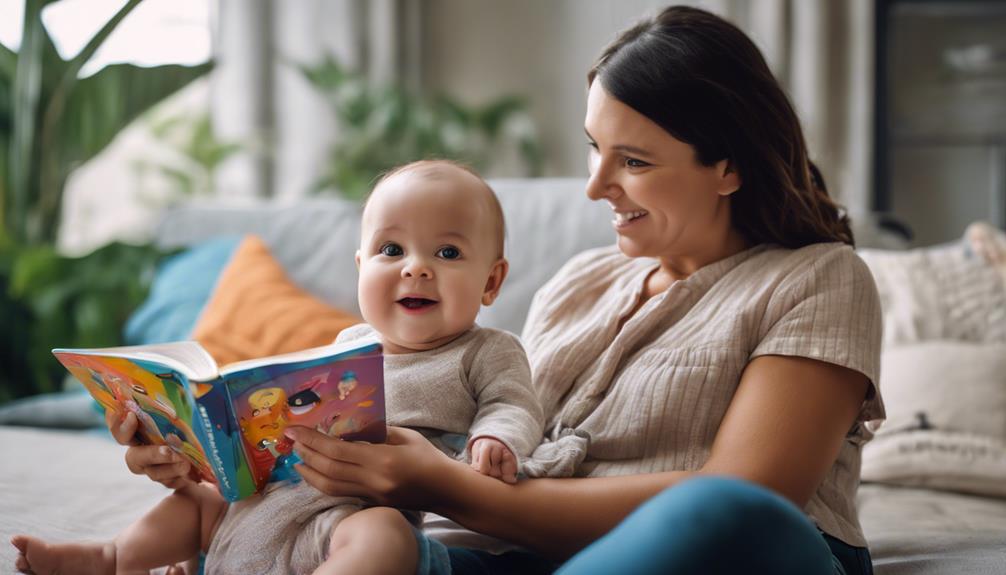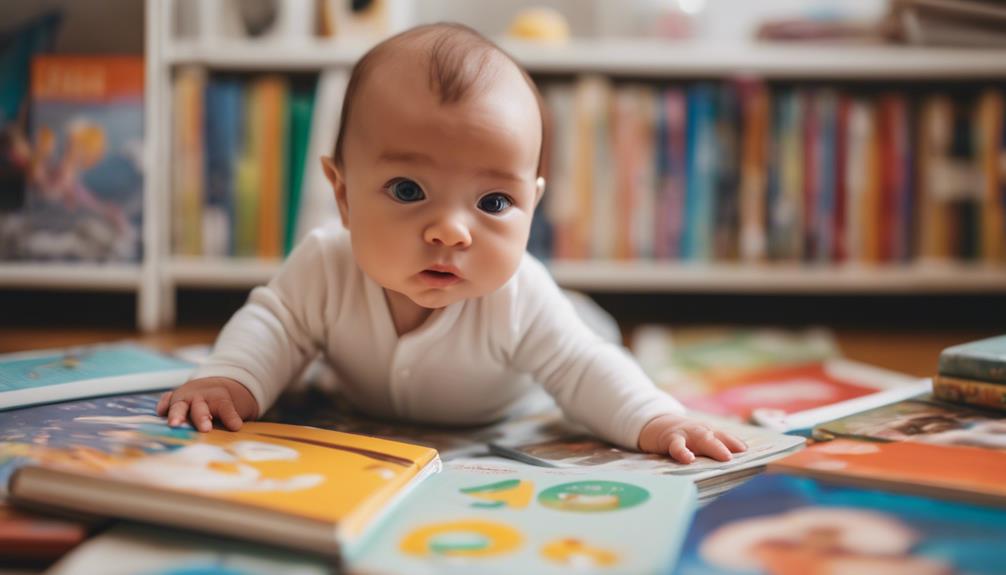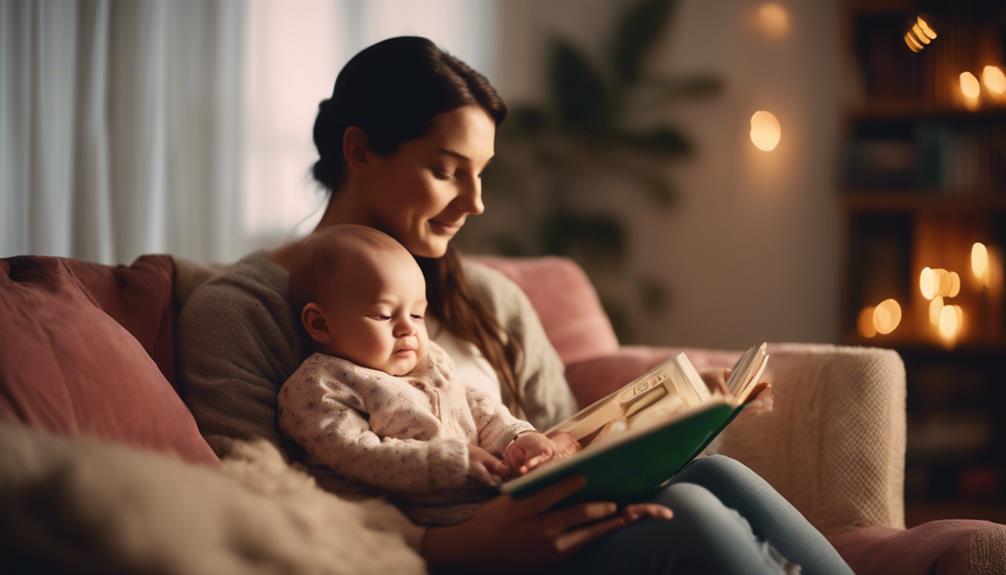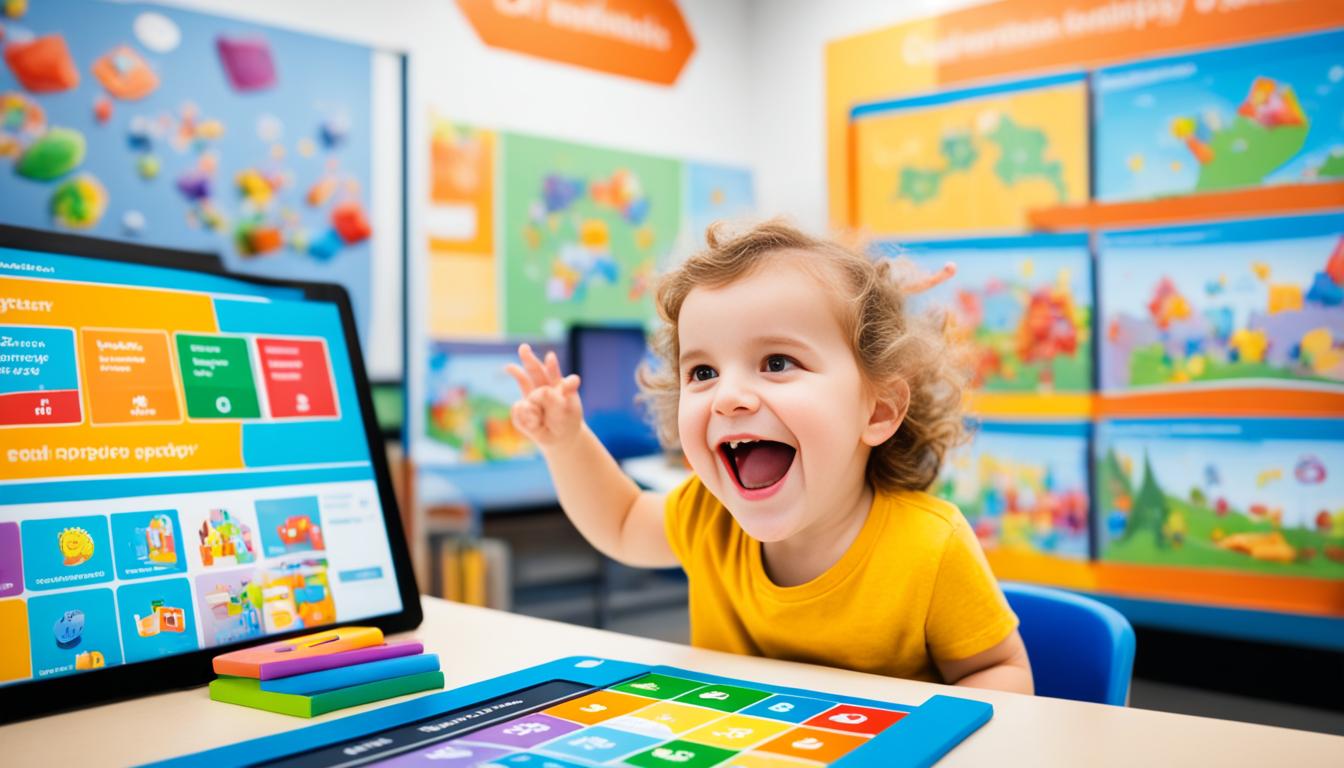Reading to your 16-month-old enhances language skills and strengthens your bond. Select age-appropriate books such as board books with engaging illustrations. Utilize interactive elements, funny voices, and gestures for active participation. Incorporate textures, sounds, and songs for interactive reading sessions. Identify key words, repeat phrases, and ask questions to expand vocabulary. Establish a daily reading routine in a cozy, distraction-free setting. For hesitant readers, provide book options, incorporate interactive features, and cultivate a positive reading atmosphere. Monitor progress by observing engagement and vocabulary development. Discover more about enhancing your child’s growth through simple reading practices.
Key Takeaways
- Choose engaging picture books with interactive features.
- Encourage active participation during reading sessions.
- Incorporate funny voices, gestures, and sound effects.
- Create a cozy, distraction-free reading environment.
- Use repetitive phrases and point out key words for vocabulary development.
Benefits of Reading to a 16-Month-Old
Reading to your 16-month-old can greatly enhance their receptive vocabulary development, with the potential for a 40% increase by this age. Receptive vocabulary refers to the words a child understands when they hear or read them.
By regularly engaging in reading sessions with your little one, you're providing them with exposure to a variety of words and concepts, which can markedly boost their language skills.
As you read to your 16-month-old, they aren't only absorbing the words you say but also the context in which those words are used. This exposure helps them better understand the meaning behind the words and how they can be used in different situations.
The more you read to your child, the more opportunities they have to expand their vocabulary and strengthen their language foundation.
Through this shared reading experience, you aren't only fostering your child's language development but also creating a special bonding time between the two of you. Enjoy these moments together and watch as your little one's receptive vocabulary grows with each story you read.
Choosing Age-Appropriate Books

When selecting books for infants and young children, it is crucial to take into account their age and developmental stage to promote engagement and learning opportunities. For newborns, opt for board books with simple, bold illustrations and high-contrast colors to captivate their developing vision. Babies aged 3-6 months will enjoy books with textures, flaps, and mirrors that stimulate their senses. Interactive board books with repetitive text and rhymes are perfect for engaging babies from 6-12 months. As children reach 12-18 months, introduce longer picture books with simple plots and engaging illustrations to hold their interest. Toddlers aged 18-24 months benefit from books with rhythmic language and interactive elements to keep them engaged and entertained.
| Age Group | Recommended Book Features |
|---|---|
| Newborns | Simple illustrations, high contrast colors, board book |
| 3-6 months | Textures, flaps, mirrors, board book |
| 6-12 months | Repetitive text, rhymes, interactive elements, board book |
Reading Techniques for Toddlers
To engage toddlers in reading, try using picture books with interactive elements like flaps and textures.
Encourage active participation by having them point to pictures, repeat words, and relate the story to their own experiences.
Incorporating funny voices and gestures can make storytelling sessions more engaging for your little one.
Picture Books for Engagement
Select picture books with vibrant illustrations and interactive features to enhance your toddler's engagement during reading sessions. Vibrant visuals and interactive elements like flaps or textures can captivate your child's attention and make the reading experience more enjoyable. Repetition of key phrases or actions in the story can help your toddler remember and participate actively. Encourage pointing to and describing objects in the pictures to promote language development. Using animated voices, different tones, and facial expressions while reading can also increase engagement and entertainment. Below is a table showcasing some engaging picture books that you may consider for your reading sessions:
| Book Title | Interactive Features | Key Benefit |
|---|---|---|
| "The Very Hungry Caterpillar" | Lift-the-flap pages | Teaches days of the week and counting |
| "Press Here" | Interactive dots to press | Encourages participation and imagination |
| "Brown Bear, Brown Bear, What Do You See?" | Repetitive text pattern | Enhances memory and language skills |
| "Where's Spot?" | Lift-the-flap hide-and-seek | Develops fine motor skills and curiosity |
Interactive Storytelling Activities
Engage your toddler in interactive storytelling activities by immersing yourself, guaranteeing funny voices, sound effects, and gestures to make the reading experience lively and engaging.
Encouraging your little one to participate in the story by asking questions, pointing at pictures, or making predictions can enhance their comprehension and enjoyment.
Utilizing props or puppets can bring the story to life, sparking your toddler's imagination and creativity.
Letting your child choose books that capture their interest not only promotes autonomy but also guarantees active engagement during reading sessions.
Creating a cozy and comfortable reading environment sets the stage for a love of books and storytelling to flourish.
By making storytelling interactive and fun, you not only nurture a strong bond with your toddler but also instill a lifelong love for reading and learning.
Interactive Reading Activities

Enhance your baby's reading experience by incorporating interactive elements such as textures, flaps, and mirrors in the books. Utilizing books with different textures will engage your baby's sense of touch, while flaps and mirrors can add an element of surprise and discovery during reading time.
Make the experience even more interactive by incorporating funny sound effects, animal noises, and songs into your reading sessions. Encourage your baby to touch and explore the books as you read aloud to stimulate their sensory development.
As you read, point to and name objects in the book to help your baby make connections between the pictures and real-life objects. This simple act can aid in your baby's cognitive development and language acquisition.
Additionally, creating a cozy reading environment with soft lighting and a comfortable seating area can make reading time a soothing and enjoyable experience for your baby. By making reading interactive and engaging, you can foster a love for books and learning in your little one from an early age.
Building Vocabulary Through Reading

To enhance your baby's vocabulary through reading, consider using word recognition techniques and engaging in interactive storytelling activities.
Pointing out and repeating key words in the story can help your baby recognize and remember them.
Encouraging your baby to interact with the story by touching textures or lifting flaps can also stimulate their sensory exploration and cognitive development.
Word Recognition Techniques
Encourage your baby's word recognition skills and vocabulary development by actively pointing to and naming objects in books during reading sessions. By repeating common words and phrases, you can help your baby start to associate them with specific objects or actions, aiding in their overall language development and word recognition.
High-contrast books with simple, bold illustrations can further enhance this process by providing visual stimulation and making it easier for your baby to identify and remember words. During reading time, engage in interactive sessions by asking simple questions about the pictures or objects in the book to promote word recognition and encourage participation.
Incorporating rhymes and repetitive phrases in books can also be beneficial in building your baby's vocabulary and language skills. These techniques not only help with word recognition but also make the reading experience more engaging and enjoyable for your little one, fostering a love for books and learning from an early age.
Interactive Storytelling Activities
Engage your baby in interactive storytelling activities to enhance vocabulary development through reading. Use funny sound effects, animal noises, and songs to make storytime engaging and fun.
Introduce books with textures, flaps, and sensory elements for tactile exploration, helping your baby connect words with real-world experiences. By incorporating touch-and-feel books, you can create a special bonding experience during reading sessions.
Select board books with colorful illustrations and simple language to capture your baby's attention and foster their language skills. These visual aids can aid in vocabulary retention and comprehension. Repeating favorite books can reinforce vocabulary learning and provide a sense of comfort and familiarity for your baby during storytelling.
Through interactive storytelling activities, you can create a dynamic and enriching reading environment that not only builds your baby's vocabulary but also strengthens your emotional bond through shared experiences.
Establishing a Reading Routine

Create a consistent reading routine with your month-old baby to establish a calming and engaging atmosphere for early literacy development.
- Set a Regular Time: Choose a specific time each day for reading to signal to your baby that it's time for a story. This consistency helps create a sense of routine and expectation.
- Designate a Quiet Space: Select a quiet and comfortable area free from distractions for your reading sessions. A peaceful environment can help your baby focus and engage better with the story.
- Use a Soothing Voice: When reading to your baby, use a gentle and soothing tone to create a relaxing atmosphere. Your voice can provide comfort and strengthen the bond between you and your little one.
Tips for Engaging Reluctant Readers

Utilize books with interactive elements such as flaps, textures, and sounds to captivate reluctant readers and enhance their interest in reading. Incorporating funny sound effects, animal noises, and songs while reading can make the experience more enjoyable for them. Allowing the child to choose books that pique their interest will increase engagement and motivation. Creating a cozy reading environment with comfortable seating and good lighting can make reading time more inviting. Encouraging a positive association with reading by praising and rewarding the child for their efforts and progress is also essential.
| Tips for Engaging Reluctant Readers |
|---|
| 1. Use books with interactive elements like flaps, textures, and sounds. |
| 2. Incorporate funny sound effects, animal noises, and songs while reading. |
| 3. Let the child choose books that interest them. |
| 4. Create a cozy reading environment with comfortable seating and good lighting. |
| 5. Encourage a positive association with reading by praising and rewarding. |
Monitoring Reading Progress

Track your baby's reading progress by monitoring their receptive vocabulary development, engagement with various book types, preferences, and interactions during reading sessions. Keep an eye on the following aspects to gauge how well your baby is progressing:
- Receptive Vocabulary Development:
Take note of new words your baby understands and uses after reading sessions. Look for an expansion in their vocabulary by around 18 months of age if reading habits are consistent.
- Engagement with Different Book Types:
Observe how your baby interacts with tactile, interactive, and rhyming books. Notice which types of books capture their attention the most and incorporate those into your reading routine.
- Preferences for Favorite Books:
Pay attention to your baby's favorite books or reading activities. Understanding their preferences can help tailor future reading sessions to keep them engaged and excited about reading.
Frequently Asked Questions
How Do I Teach My Newborn to Read?
To teach your newborn to read, start by reading to them in a soothing voice. Use high-contrast board books and point out simple pictures. Make reading part of your routine and stop if they seem uninterested.
What Age Should I Start Teaching My Baby to Read?
So, when should you start teaching your baby to read? Well, around 6 months is a great time to begin. Reading to your little one regularly can boost their vocabulary development and engage their senses.
What Is the Earliest Age to Start Reading?
You can start reading to your baby as early as a few weeks old. Reading helps in bonding, soothing, and laying the foundation for language development. Early exposure to reading creates a positive association with books and learning.
How to Make a Baby Read?
To make a baby read, start by establishing a daily reading routine, using engaging voices and gestures, pointing to pictures, letting them touch the book, and choosing age-appropriate, interactive books with colorful illustrations to captivate their attention.
Conclusion
To sum up, reading to your 16-month-old not only helps with language development but also fosters a love for books at an early age.
Just like a seed needs water to grow, your child's mind needs the nourishment of reading to flourish.
So keep those books handy, engage in interactive reading activities, and watch as your little one's vocabulary and love for stories blossom like a beautiful garden.
Happy reading!










